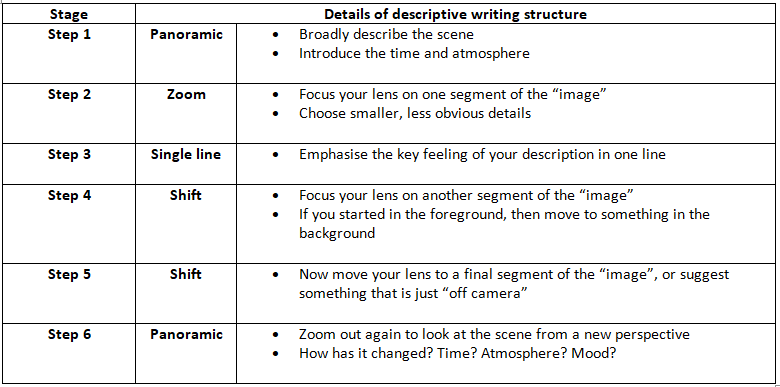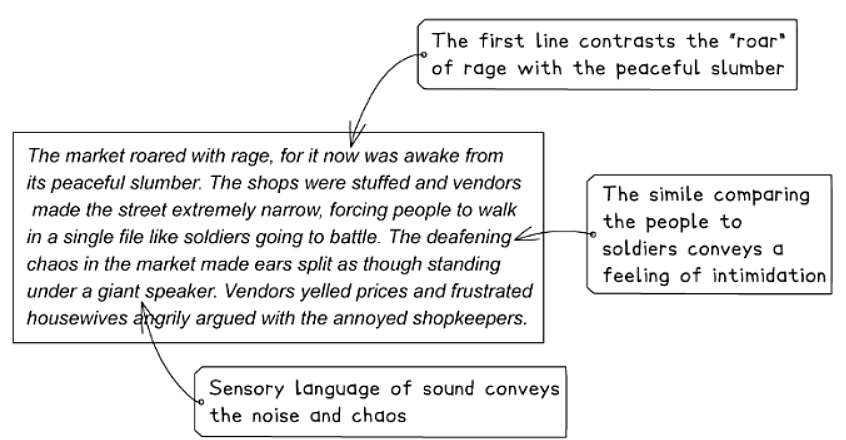Assignment 2: Descriptive Writing | English Language for GCSE/IGCSE - Class 10 PDF Download
| Table of contents |

|
| Introduction |

|
| Overview |

|
| Assignment examples |

|
| How to write to describe |

|
| Top tips |

|
Introduction
Assignment 2 in your coursework portfolio entails crafting a descriptive piece of writing. To achieve the highest marks, you need to expand on ideas and imagery that construct a compelling and clearly delineated scene with diverse points of emphasis.
The following guide is divided into the following sections:
- Overview
- Assignment examples
- How to write to describe
- Top tips
Overview
In this task, your writing abilities are evaluated exclusively, and your composition should span between 500 and 800 words. Content and structure are worth 10 marks, while style and accuracy carry a weightage of 15 marks.

Keep in mind that in descriptive writing, your goal is to help the reader visualize what you're describing. You're not crafting a narrative, but descriptive writing can encompass emotions, a sense of location and ambiance, as well as shifts in perspective and time.
Assignment examples
You might encounter tasks where you're required to depict a bustling location like a café, market, or train station, or capture the essence of a significant event or celebration. Conversely, you could be tasked with describing a moment frozen in time or a natural phenomenon like a sunrise or sunset. The key is to ensure your portrayal is dynamic, and the most effective responses often draw from personal experiences.
How to write to describe
Descriptive writing involves keen observation without interaction with the surroundings or characters. It resembles capturing a snapshot with a camera, focusing on vivid details of a moment. However, this doesn't imply a static scene; it's crucial to acknowledge and depict movements and actions occurring within the described setting.
Below is a suggested step-by-step structure for a piece of descriptive writing, including the techniques to use during each of the six steps:
- Ensure that any action or movement included in your description does not lead to interaction with other characters or settings and does not advance the plot. Actions should occur within a short period of "real time," such as the wind knocking over a basket. Contrasting moving elements with static ones can enhance the descriptive effect.
- Connect paragraphs effectively while varying their length and structure to maintain reader engagement. A diverse and accurate depiction of the scene should enable readers to vividly imagine and experience it through their senses.
Tone
When composing descriptive writing, aim to align your tone with the mood of the scene. Your sentences should resonate with the atmosphere, mirroring its emotional nuances. For instance, if the scene evokes mystery and fear, your sentences should convey this sense of suspense.
In order to craft a tone in keeping with the mood of your description, consider how you can use sentence lengths and types:
- Short sentences can convey tension and unease. For instance, "No sound could be heard." This brevity adds a sense of suspense.
- On the other hand, longer sentences and lists can depict abundance or feeling overwhelmed. Consider this example: "The market was filled with apples, grapes, oranges, loaves of bread, cheese, and various vegetables." Such descriptions create a rich, detailed picture.
Style and Register
The manner in which you craft your descriptive writing is intricately tied to the language you employ. For instance, within a descriptive writing piece, superior responses showcase meticulous selection of words and the purposeful application of linguistic methods.
Descriptive writing serves to enable the reader to imagine the individual, location, or circumstance being portrayed. Your choice of words and linguistic methods ought to evoke a lively, sensory depiction within the reader’s imagination.
The best way to do this is to:
- Employ vocabulary that enriches the reader's understanding:
- Avoid generic terms like "brilliant" or "amazing" in favor of precise, expressive adjectives.
- Opt for specific and imaginative adjectives to enhance your descriptions.
- Utilize sensory language to evoke a vivid depiction:
- Engage not only sight but also hearing, smell, and touch to immerse the reader in the scene.
- Highlight significant concepts using language techniques and vivid imagery:
- Employ similes to draw comparisons about size or color, enhancing the reader's visualization.
- Consider personification, particularly when describing weather or inanimate objects, to imbue them with life.
- Capture essential details:
- Focus on conveying key features rather than providing exhaustive descriptions of every aspect of a person or scene.
When considering the detail you should include in your description, it is useful to consider the types of things that bring a scene to life. These things are normally rooted in contrast. For example: Let’s consider the following example of an opening paragraph of a piece of descriptive writing:
Let’s consider the following example of an opening paragraph of a piece of descriptive writing:
Top tips
- Your description should be closely observed and focused on imagery:
- Strive to utilize unique and vivid images, avoiding clichés, to enhance the impact of your writing.
- Ensure every word you select contributes to the overall mood and tone you intend to create.
- Avoid mixing tenses within a paragraph. For instance, if you introduce a flashback, maintain consistency by narrating it in the past tense.
- Consistently use present tense verbs if you wish to create a specific effect in your writing.
- Avoid incorporating dialogues in descriptive pieces. Remember, descriptive writing primarily focuses on visual details rather than conversations or character development.
- When depicting individuals, emphasize their gestures and movements to bring them to life in the reader's mind.
- Imitate the function of a camera by zooming in and out of the scene you are describing, adding depth and interest to your writing.
- Employ sensory language to evoke emotions and set the mood. However, adjust the focus and viewpoint as your narrative progresses. While descriptive writing should engage multiple senses, the narrator remains an uninvolved observer.
- Vary the lengths of your sentences and paragraphs to maintain a dynamic style and tone throughout your piece.
- Reiterating color-related ideas can be impactful. Consider highlighting a specific detail, such as the color of rooftops, to reinforce certain themes or elements in your writing.
- Remember, descriptive writing is not bound by the constraints of a traditional story structure. There is no obligation to offer a conclusive or 'happy' ending.
|
16 videos|45 docs
|
FAQs on Assignment 2: Descriptive Writing - English Language for GCSE/IGCSE - Class 10
| 1. How can I improve my descriptive writing skills? |  |
| 2. What are some techniques to make my descriptions more engaging? |  |
| 3. How important is it to include specific details in descriptive writing? |  |
| 4. How can I create a strong tone in my descriptive writing? |  |
| 5. What are some common mistakes to avoid in descriptive writing? |  |














